English Language Honours Options
Reading the Past: from script to print
Late Medieval English Literature
Resources in Special Collections
John Gower Vox
Clamantis, etc
England: c.1400 MS
Hunter 59 (T.2.17)
|
'Moral Gower', as Chaucer calls him in
Troilus and Criseyde, used the Peasants Revolt of 1381 in his Vox
clamantis to describe the faults of the various classes of society.
The earlier portion of the work contains a vivid account of the uprising in the form
of an allegory; the remainder is a version in Latin of the strictures
that he had already made in a 30,000 line poem in French, the
Speculum meditantes.
In this copy of the revised version of the
Vox clamantis and Chronica tripertita, the text is
preceded by a full page representation of the author firing his shafts
at the world (folio 6v). This globe is composed of the elements of air, earth and
water in three compartments. A second illustration (folio 129r) includes
a shield with the Gower arms supported by two flying angels, with a
cloth-covered bier at the foot of the page; Gower did not die, however,
until 1408, some years after this manuscript was written. There is a
palimpsest of a third illustration on folio 131v, but its details have
been lost.
|
|
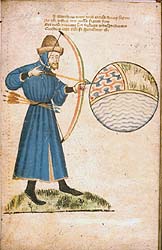
folio 6v |
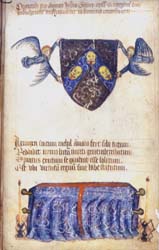
folio 129r |
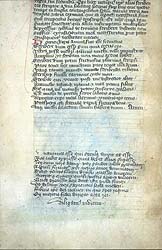
folio 131v |
|
John Gower Confessio
Amantis
England: fifteenth century (second quarter) MS
Hunter 7 (S.1.7)
| This is Gower's most
acclaimed English work. Completed in its first version in 1390, when
Gower was about sixty, it is a lover's account of his confession to
Genius, the priest of Venus, under headings supplied by the seven deadly
sins: these are illustrated by tales in which the general nature of the
sin is described together with the particular forms it may take in a
lover. The poet ultimately receives absolution and is dismissed from the
service of Venus, for which his age makes him unfit.
The decorative scheme in this manuscript was for the
beginning of each book to be marked by an illuminated and decorated
page. However, several of these pages (including the beginnings of books
one, two, six, seven and eight), have been lost and this may mean that
they originally included miniatures as well. The floral and leaf motifs
of the surviving decorated pages are in the same style as the spraywork
of many of the borders in a Book of Hours and Psalter in the Pierpont
Morgan Library, and Kathleen Scott has suggested that they may be from
the same workshop. There is a seventeenth century inscription in the
book indicating that it was owned by the Benedictine Abbey of Bury St
Edmonds: if this is correct, then this copy is likely to have been read
by John Lydgate.
|
|
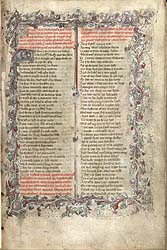
folio 1r |
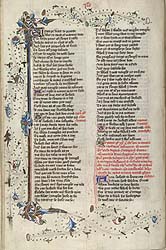
folio 65v |
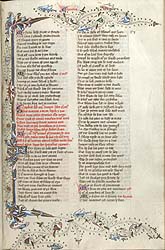
folio 87r |
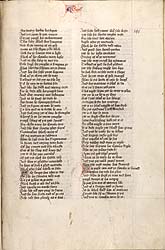
folio 141r |
Chaucer Romaunt
of the Rose
England: c.1440-1450 MS
Hunter 409 (V.3.7)
|
Originally composed in
French in the thirteenth century by Guillaume de Lorris and Jean de
Meun, this poem on the art of love was one of the most popular of all
poems in the Middle Ages. Probably written in the first half of the
thirteenth century, it is an allegory of courtly love designed for the
amusement of an aristocratic audience. Less than a third of Chaucer's
Middle English translation of the poem has survived. Although the
question of the authorship of the translation has caused considerable
argument, it has become generally accepted that Chaucer wrote the first
section of what remains, to line 1705, and that this was completed
before he left for Italy in 1372. This manuscript is extremely important
in being the only extant copy of Chaucer's poem and is itself
incomplete. It was copied
in an English vernacular script c.1440-1450, some decades after
Chaucer's death in 1400. It was bought by William Hunter on 18 May 1774
at the sale of the antiquarian Thomas Martin of Palgrave. Elegantly
decorated throughout with gilt letters and floral sprays, there are
several particularly ornate pages embellished with an abundance of
floral designs, chiefly of Lords-and -Ladies or Cuckoo Pint. This flower
is an appropriate accompaniment to a poem on love, and the artist has
made exuberant play with its suggestive appearance. It has been demonstrated that this volume was used by
William Thynne as the copy text for his 1532 edition of Chaucers' works.
Thynne clearly marked off sections of the text in order to make up
the pages of print: on folio 6r, for example, the '6' in ink to the
right of the page indicated where page 6 of the printed text was to
begin.
This manuscript (along with the library's
copy of the Thynne
edition (Sp Coll Hunterian Bs.2.17)) has been digitised in its entirety:
go to Romaunt
of the Rose pages mounted by English Language Department.
|
|
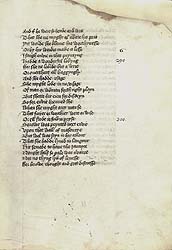
folio 6r |
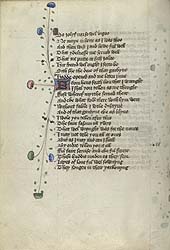
folio 13v |
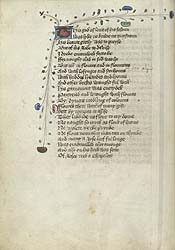
folio 17v |
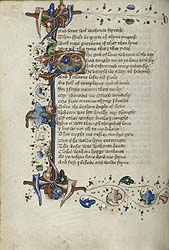
folio 57v |
John Lydgate Fall
of Princes
England: c.1470-1480 MS
Hunter 5 (S.1.5)
| John Lydgate
(c.1370-1449) was a monk at the great Benedictine Abbey of St Edmund at
Bury. He is credited with some 145,000 lines of verse, almost a quarter
of which is contained in the Fall of Princes, his single longest
work. The poem is based on Laurent de Premierfait's translation of
Boccaccio's De casibus virorum illustrium. Lydgate greatly
amplifies the French text, however, with additions from a variety of
sources including the Bible, Ovid and other works by Boccaccio. The
result is a universal encyclopaedia of history and mythology, somehwat
ponderous in tone and exhaustively fleshed out with moral teaching. The
work was commissioned from Lydgate in 1431 by Humphrey, Duke of
Gloucester, younger brother of Henry V and Protector of England during
the minority of Henry VI, and it occupied the following eight years of
his life.
This is an imposing de-luxe copy of the
work, written out in a very neat hand. Its major decoration is found in
six full page borders (folios 41r, 125v, 139r, 161r, 172r and 191r),
filled with delicate sprays of penwork in a foreign style, in which an
elegant balance of colour is provided by leaves, flower patterns and
gold highlights. Like our copy of Gower's Confessio Amantis, this
copy is incomplete, the pages at the beginning of Books three and four
being cut out, probably for their decoration. One of the quires has also
been misbound, and several notes in an early seventeenth century hand
(including the instruction on one folio to 'Turne forwards eight leaves')
attempt to make this explicit to any reader. Another interesting feature
is a number of crossed out lines on folio 197r obliterating references
to the female 'Pope Joan'. There are several early
ownership inscriptions at the end of the volume, including records of
the births of some members of the Lumner and Calthorpe families in the
Sixteenth Century.
|
|
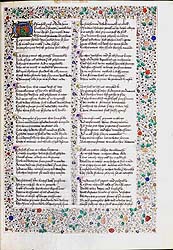
folio 41r |
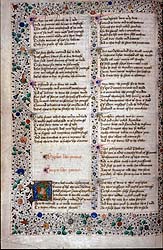
folio 125v |
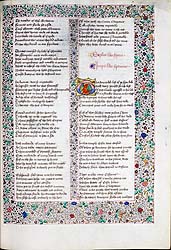
folio 161r |
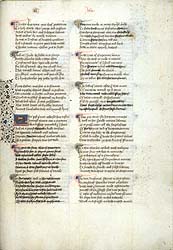
folio 197r |
Nicholas Love Mirror of
the Blessed Life of Jesus Christ
England, Sheen: 1475 MS
Hunter 77 (T.3.15)
| The Meditationes
Vitae Christi, a devotional life of Christ originally written in
Latin, was extremely popular throughout medieval Europe. The Mirror
is a free tranlsation of the work, made by Nicholas Love (d.1424). Its
purpose was to dispense meditative and doctrinal comment on the Bible:
its sixty three chapters are each split into seven sections, each
section representing a day of the week. This
is a fairly high grade manuscript written in an expert Anglicana Formata
on good quality vellum. It boasts several floreated pages, with
illuminated initials and decorative penwork throughout. Stephen Dodesham
(d.1481/82), the scribe of this manuscript, is identified from a
contemporary inscription on a flyleaf. He was a monk of Witham
Charterhouse near Frome, Somerset; he later moved to Sheen Charterhouse
in Richmond, Surrey, founded by Henry V in 1414. Dodesham was a prolific
scribe whose career began in the late 1420s; over twenty of his
manuscripts survive, including two others in the Hunterian collection:
Richard of St Victor's De preparatione animi ad contemplationem,
and Dionysius Cato's Disticha de moribus ad filium, both of which
were originally part of the same volume (now MSS Hunter
258 and
259).
|
|
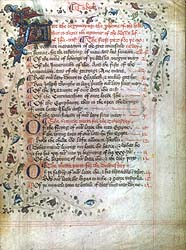
folio 1r |
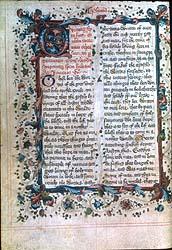
folio 3v |
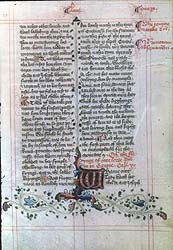
folio 38r |
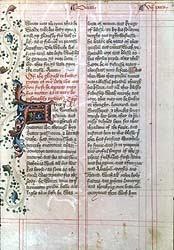
folio 133r |
Chaucer Canterbury
Tales
England: 1476 MS
Hunter 197 (U.1.1)
| Eighty odd
complete and fragmentary copies of Chaucer's most celebrated poem,
The Canterbury Tales, survive today. The colophon of this copy
supplies the information that this manuscript was written by Geoffrey
and Thomas Spirleng and completed in January 1476 (folio 102v). Geoffrey
Spirleng is mentioned occasionally in the Paston letters; he worked
first as an estate servant for Sir John Falstof and then as a civic
official in Norwich; the colophon indicates that he was born in about
1426. Although Geoffrey acknoweldges his son Thomas' help in writing out
the text, in fact he carried out most of the work himself. Written on
paper, the manuscript's leaves are generously sized but the layout of
the text is economical with no attempt at expensive decoration. It is
written in an ordinary cursive business hand, a variable mix of
Secretary and Anglicana. It was probably copied by the Spirlengs for
their own use. This is a somewhat
eccentrically ordered copy of the poem, with the Latin text of the
legend of St Patrick's Purgatory now appended at the end (folios
116r-130). It has been established that the first forty-six leaves of
the manuscript were derived from another extant copy (now in Cambridge
University Library), which at the time belonged to another Norfolk man.
However, from 47v onwards, a different examplar was used; this second
manuscript was differently ordered from the first and consequently the
Spirlengs copied the 'Shipman's Tale' and 'Prioress's Tale' out twice,
while initially omitting the 'Clerk's Tale' and 'Canon's Yeoman's Tale'
altogether. Having written out the colophon and copied St Partick's
Purgatory, it was noticed that these two tales were missing. The
second exemplar had evidently been returned, but Spirleng accessed the
first copy text again to make good the omissions on an additional quire
(now folios 103-115), using a different paper stock from that of the
main manuscript. This insertion obviously spoiled the colophon's effect,
so Spirleng added an explanatory note at the end of the 'Parson's Tale'
and deleted the original colophon. The colophon was then repeated on
folio 115v. These mistakes are a fascinating glimpse into manuscript
transmission in the Fifteenth Century: that two tales were copied out
twice and that two exemplars were used suggests that the manuscript was
written in a very piecemeal fashion, probably fitted in amongst
Spirleng's administrative duties whenever possible.
|
|
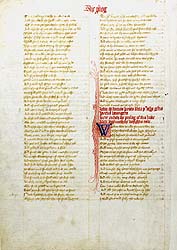
folio 3v |
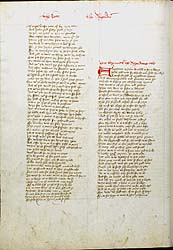
folio 77v |
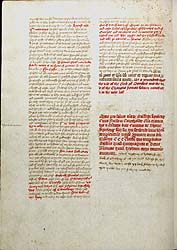
folio 102v |
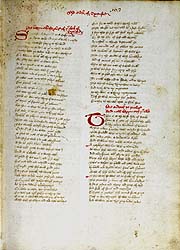
folio 103r |
Return to top of the page
|